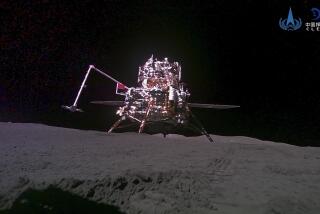SCIENCE : U.S. Has Chipped Away at Stash of Moon Rocks : Scientists use core samples from Apollo missions to probe lunar puzzles. Only 4 of 54 remain untouched.
- Share via
HOUSTON — When the last Apollo astronaut’s memory has blurred, the only real evidence of humanity’s first venture to another world will be a cache of gray rocks in a guarded vault that proves Earth and the moon, however distant, are one.
Twenty-five years after the Apollo 11 astronauts returned to Earth with the first bag of moon rocks, 65 scientists around the world still are using NASA’s unique collection of lunar samples to analyze the history of Earth’s nearest neighbor.
Rarer than diamonds, as closely guarded as bank bullion, the nondescript chunks of breccia, feldspar and basalt plucked from the surface of the moon have helped open a window into the earliest moments of the solar system, answering some of the most fundamental puzzles about the moon and its origin.
“In retrospect, it was almost comical how ignorant people were about the moon,” said James L. Gooding, curator of the lunar sample laboratory at NASA’s Johnson Space Center in Houston, where the moon rocks are stored.
“There were lots of theories, lots of ideas and a complete lack of information. What the samples have taught us so far is the skeleton of lunar history,” Gooding said.
“There are a lot of gaps. Twenty-five years later, people are still asking for details.”
To satisfy the demand, lab technician Linda Watts is still slicing moon rocks. She has worked in the lab 17 years.
At a measured pace that makes a diamond cutter seem precipitous, Watts takes six months to prepare the samples from a single pristine core of moon rock. Three times a year, a committee doles out the samples.
One day soon, however, she will have worked herself out of a job.
Apollo astronauts brought back 54 core samples from the lunar surface. Now only four are unopened and uncontaminated. Five years ago, there were eight.
In all, the 12 Apollo astronauts who walked on the moon from 1969 to 1973 collected 842 pounds of lunar rocks, pebbles and dust from six spots on the moon. With no plans to return to the moon, there is no chance that anyone will prospect for more soon. The only other known lunar rocks are a few meteorites found on the Antarctic ice sheet in the past decade.
“When the science community realized that this was the world’s fixed, limited supply of lunar samples, they became pretty concerned about their safety,” Gooding said.
NASA takes extraordinary care to keep its rocks unsullied by Earth’s atmosphere or bacteria. Each sample is stored inside a double thickness of Teflon and then bolted inside a sealed stainless steel container flooded with nitrogen gas. The containers are isolated by an air lock and a 14-ton vault door with two separate combination locks. The vault is monitored by security guards, motion sensors and video cameras.
The agency also follows an elaborate accounting procedure to ensure none are lost or stolen.
Whatever their inherent scientific value, the moon rocks also are souvenirs of a $25-billion space race with the Soviet Union, in which U.S. astronauts won by simply touching the moon.
Today, there is a piece of the moon in almost every state and nearly every one of the world’s nations, most distributed as diplomatic largess in the Richard Nixon-era “spirit of Apollo.”
There is even a piece of the moon in Pasadena--on display at the Jet Propulsion Laboratory.
After decades of investigation, the moon samples convey a complex saga to scientists.
The chemistry of the rocks suggests the moon formed from the same material as the planet it orbits, providing key evidence for the theory that the moon was formed out of the molten splash caused when some object collided with Earth 4.5 billion years ago--the approximate age of the oldest moon rocks.
The rocks show that the moon has never known life, has no water, and no sedimentary layering. All of the rocks examined were produced by extreme heat and melting caused by volcanic eruptions or by intense meteor bombardment.
The rocks also revealed the one thing scientists had not expected--traces of a planetary magnetic field like Earth’s.
Increasingly self-conscious about the dwindling store of pristine moon samples, lunar scientists are quick to take advantage of advances in electron-beam probes and other techniques that allow them to look for trace elements, isotopes and other characteristics.
“In 1970, to do that kind of analysis, you would have needed a chunk of rock big enough to hold in your hand,” Gooding said. “In 25 years, the technology has advanced to the point you can do the same thing with a tiny grain of material.”






